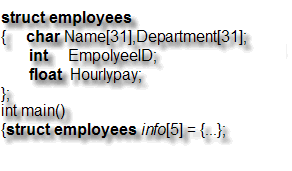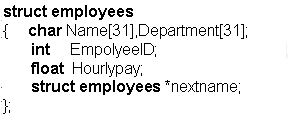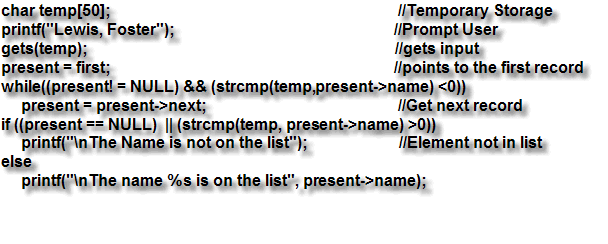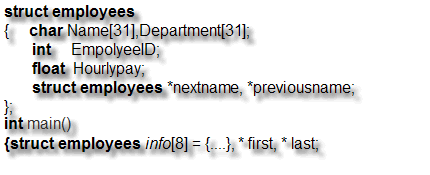 How
do the different types of linked lists compare?
How
do the different types of linked lists compare?

By Definition: A linked
list is a structured data object (struct) which relies on pointers
between elements. In essence, a linked list creates a chain of
"nodes" which utilize pointers/elements to identify where the next
link in the chain is located.

There are several reason to learn the advantage and
disadvantages of linked list, which will be discuss in detail
later? But for now lets learn how to crawl before we start
running!!
Below is a simplistic
representation of a linked list.
Note: Before analyzing this
representation keep a few things in Mind.
-
Elem = Element (An address that
pertains directly to that node/record )
-
Node = Each node contains two
fields to store whatever element type the user wants and an
additional field, which is not visible in this illustration, but
points to the next node in the chain linking one node to the
next.


But haven't we
covered this in the Searching and Sorting Chapter; as well as, the
Array Chapter. Furthermore, why is this technique any better than
those.
Well yes, we can utilize
Searching/Sorting and Arrays to do basically the same things but
they are some major draw backs to those techniques.
-
One problem we encounter
with arrays is that we have to know exactly how much storage in
Ram we need, what happens if you don't?
-
Arrays require us to
allocate contiguous bytes of storage, what happens when we don't
have it?
-
Searching/sorting will
require us to sort (and resort) every time we wish to display by
a different key, this will take a tremendous amount of effort.
Tables will resolve all of these
problems for US, but they to have drawbacks...
Now that we have a basic
understanding of linked list and some of the problems with using
Arrays and Searching/Sorting let take a look at the different types
of liked lists and how they compare and contrast.

Scenario: We often find ourselves
in a situation that requires us to sort and resort a table of
information. Lets further assume that this information consisted of
five individual employees (Employee ID, Name, Hourly Pay, and
Department).
|
Offset\Field (Element) |
EmployeeID |
Name |
Hourly
Pay |
Department |
| 0 |
24653 |
Andrew, John |
7.89 |
Payroll |
| 1 |
37896 |
Hemmingway, Joseph |
10.24 |
Accounting |
| 2 |
56987 |
Lewis, Foster |
12.56 |
Manufacturing |
| 3 |
59843 |
Rodriguez, Jazmin |
10.24 |
Payroll |
| 4 |
65203 |
Marshal, Fredrick |
7.89 |
Human
Resources |
Note: At this current time our table is sorted by
employee ID. What if your boss told you to provide a report which
list the employee's above by Name (alphabetically of course
otherwise there is no use for this example).
Before we move on lets
keep a few thinks in mind..
The variables in our program that would be
associated with the above table would look as follows:

Now since we have decided, or our boss has decided
for us, to provide a report of the employees sorted by name we could
simply add an additional field which would be the pointer to the
next record in the table. Our table would know look like this...
| Offset\Field
(Element) |
EmployeeID |
Name |
Hourly Pay |
Department |
nextname |
| 0 |
24653 |
Andrew, John |
7.89 |
Payroll |
Hemmingway,
Joseph |
| 1 |
37896 |
Hemmingway,
Joseph |
10.24 |
Accounting |
Lewis, Foster |
| 2 |
56987 |
Rodriguez,
Jazmin |
12.56 |
Manufacturing |
**No one** |
| 3 |
59843 |
Lewis, Foster |
10.24 |
Payroll |
Marshal,
Fredrick |
| 4 |
65203 |
Marshal,
Fredrick |
7.89 |
Human
Resources |
Rodriguez,
Jazmin |
Keep in mind what is actually happening, our objective is to display
the list alphabetically by name, so we go to the first name in the
list ("Andrew, John"), display the record information, and then look
at the name in the nextname field ("Hemmingway, Joseph"), go
to that record and display the information which will point us to
the next record ("Lewis, Foster"). This will continue to display
the names in alphabetical order until it reaches ("**No one**" or
the null value).

Well this is interesting but how much storage will
be need for a case like this? What additional steps do I need to
consider when using a singly linked list?
Well, each record would require 31 + 31 + 2 + 4 =
68-bytes of storage. We also need to include an additional 4 byte
for the pointer field ("nextname" field in the example above) which
brings the grand total to 72. Since we wish to store 5 records, we
would require a total of 72 * 5 = 360 contiguous bytes of storage.
We would also have to edit our structure template to look like
this..


All told, like anything else, their are advantages
and disadvantages to using a singly linked list...
|
Advantages of Singly
Linked List |
Disadvantages of
Singly Linked List |
| Allows for display in order w/o sorting |
Additional Ram due to pointer Field |
| Can order on any field |
Additional Programming needed |
| Easy to establish and maintain |
|
| Need not search until list end if an element
is not on the list |
|
Let me take this opportunity to expound on a few
of the advantages above. Specifically, "Can order on any field" and
"Need not search until list end if an element is not on the list".
Example: Suppose we decide to search for a
particular name ("Lewis, Foster") in our linked list. We could
simply add some additional code that will take the following form.


|
Search Element No: Get Next
|
 This
additional programming will allow us to step through our program
as follows:
This
additional programming will allow us to step through our program
as follows:
| Offset\Field
(Element) |
EmployeeID |
Name |
Hourly Pay |
Department |
nextname |
| 0 |
24653 |
Andrew, John |
7.89 |
Payroll |
Hemmingway, Joseph |

| 1 |
37896
|
Search Element No: Get Next
|
 |
Hemmingway, Joseph |
10.24 |
Accounting |
Lewis, Foster |

| 3 |
59843 |
Lewis, Foster |
10.24 |
Payroll |
Marshal, Fredrick |




Before beginning I should note that a Doubly Linked
List implies that the list is linked in both direction, ergo this
would allow us to search from bottom up or top down, one thing we
were unable to perform with the singly linked list (without a little
manipulation off course).

Not much, but how often do you really only have 5 records to
maintain. Realistically speaking, we would never go through all
this trouble for five records. The real world dictates that we
maintains hundreds of thousands of records and in this case if we
were to use the singly linked list it would be very time consuming
to sort through them all to identify just one.
Note: For simplistic purpose we will continue to
use the example provided above.
| Offset\Field
(Element) |
EmployeeID |
Name |
Hourly Pay |
Department |
previousname |
nextname |
| 0 |
24653 |
Andrew, John |
7.89 |
Payroll |
**No one** |
Hemmingway,
Joseph |
| 1 |
37896 |
Hemmingway,
Joseph |
10.24 |
Accounting |
Andrew, John |
Lewis, Foster |
| 2 |
56987 |
Rodriguez, Jazmin |
12.56 |
Manufacturing |
Marshal, Fredrick |
**No one** |
| 3 |
59843 |
Lewis, Foster |
10.24 |
Payroll |
Hemmingway,
Joseph |
Marshal, Fredrick |
| 4 |
65203 |
Marshal, Fredrick |
7.89 |
Human Resources |
Lewis, Foster |
Rodriguez, Jazmin |
To accomplish this feet, we would also have to
edit our structure template, it should appear as so...


Additionally, our record would require 31 + 31 + 2 +
4 + 4 + 4= 76-bytes of storage. Keep in mind 8 bytes will be
allocated to the pointers ("nextname", "previousname" field in the
example above). Since we wish to store 5 records, we would require a
total of 76 * 5 = 380 contiguous bytes of storage.
In addition to the advantages and disadvantages of
singly liked lists we will also add the following for Doubly Linked
Lists.
|
Advantages of Doubly
Linked Lists |
Disadvantages of
Double Linked Lists |
| Can search & display from either end of the
table |
Additional RAM due to extra pointer fields |
| |
Additional Programming needed |
References for Further Clarification
-
How to think like a computer scientist
-
Web Encyclopedia
-
Fortune City
-
http://encyclopedia.laborlawtalk.com/Linked_list#Doubly-linked_list
Helpful Questions
- List Advantages and Disadvantages of Linked List (Singly
and Doubly)?
|
Advantages of Singly
Linked List |
Disadvantages of
Singly Linked List |
| Allows for display in order w/o sorting |
Additional Ram due to pointer Field |
| Can order on any field |
Additional Programming needed |
| Easy to establish and maintain |
|
| Need not search until list end if an element
is not on the list |
|
|
Advantages of Doubly
Linked Lists |
Disadvantages of
Double Linked Lists |
| Can search & display from either end of the
table |
Additional RAM due to extra pointer fields |
| |
Additional Programming needed |
2. I have five automobiles which I have listed in a
spreadsheet as follows,
set
up the needed structure template (call it struct
automobilesemplate) to link the list alphabetically by author (make
up string lengths as you see fit).
| Make |
Model |
Year |
Value |
| Ford |
ZX2 |
2002 |
5000.69 |
| Chevy |
Corsica |
2005 |
9000.27 |
| Dodge |
Viper |
2005 |
40,000.69 |
| Mercury |
Marine |
2005 |
29,000.57 |
| Isuzu |
Trooper |
1998 |
2000.00 |
struct automobilestemplate { char Make[30],
Model[25];
int year;
float value;
struct automobiletemplate * next; };
The manner in which I have set up the template requires:
30 + 25 + 2 + 4 + 4 = 65 bytes of storage per record, or 5 * 65
= 325 bytes of contiguous RAM allocation.
True and False
- When using Linked list we need to allocate an additional 2
bytes for storage per pointer.
False, an additional 4 bytes of storage is needed for
each pointer.
2. When utilized a singly linked list we can not
specifically search for a particular name without having to search
the entire table.
False, using a singly linked list we can
specific which record we are looking for and end the program
without searching any further.

 CIS3355:
Business Data Structures
CIS3355:
Business Data Structures